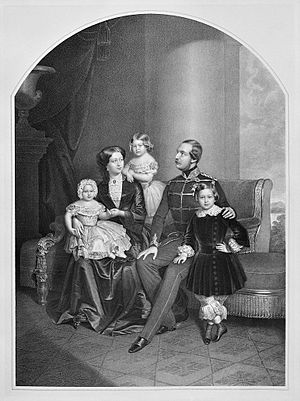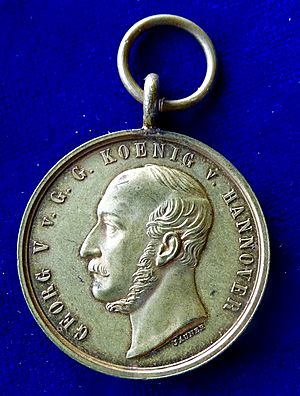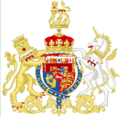George V of Hanover facts for kids
Quick facts for kids George V |
|||||
|---|---|---|---|---|---|
| Duke of Cumberland and Teviotdale | |||||
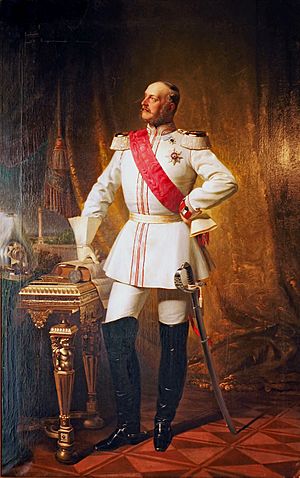
Portrait by Conrad L'Allemand, 1861, now in Celle Castle
|
|||||
| King of Hanover | |||||
| Reign | 18 November 1851 – 20 September 1866 |
||||
| Predecessor | Ernest Augustus | ||||
| Successor | Monarchy abolished | ||||
| Born | 27 May 1819 Berlin, Prussia |
||||
| Died | 12 June 1878 (aged 59) Paris, France |
||||
| Burial | 24 June 1878 Royal Vault, St George's Chapel, Windsor |
||||
| Spouse |
Marie of Saxe-Altenburg
(m. 1843) |
||||
| Issue | Ernest Augustus, Crown Prince of Hanover Princess Frederica, Baroness von Pawel-Rammingen Princess Marie |
||||
|
|||||
| House | Hanover | ||||
| Father | Ernest Augustus, King of Hanover | ||||
| Mother | Frederica of Mecklenburg-Strelitz | ||||
| Religion | Lutheran | ||||
| Signature | |||||
George V (born Georg Friedrich Alexander Karl Ernst August; 27 May 1819 – 12 June 1878) was the very last King of Hanover. He was the only child of King Ernest Augustus.
George V's time as king ended because of the Austro-Prussian War. After this war, Prussia took over Hanover.
Contents
Early Life of Prince George
Prince George of Cumberland was born on 27 May 1819 in Berlin. He was the only son of Prince Ernest Augustus, Duke of Cumberland and Teviotdale. His father was a son of King George III of the United Kingdom.
George was baptized on 8 July 1819. Many important people were his godparents, including the Prince Regent (who later became King George IV of the United Kingdom).
George spent his childhood in Berlin and Great Britain. He lost sight in one eye in 1828 due to an illness. Later, in 1833, he lost sight in his other eye after an accident. This meant he became completely blind.
His father hoped that George might marry his cousin, Queen Victoria. She was only three days older than him. This marriage would have kept the British and Hanoverian thrones together, but it never happened.
Becoming Crown Prince
When King William IV died, Queen Victoria became the Queen of Britain. However, a special law in Hanover, called semi-Salic law, meant that a woman could not become its ruler.
Because of this, the Duke of Cumberland (George's father) became King Ernest Augustus of Hanover. Prince George then became the Crown Prince of Hanover.
Even though he was blind, his father decided that George should still become the next king of Hanover.
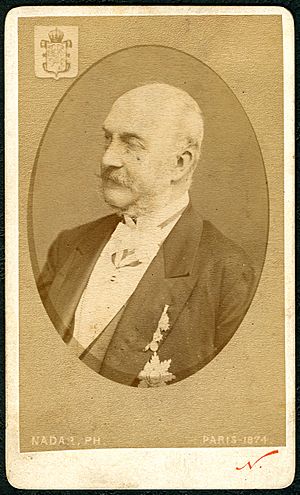
Marriage and Family
On 18 February 1843, George married Princess Marie of Saxe-Altenburg in Hanover. She was the oldest daughter of Joseph, Duke of Saxe-Altenburg.
They had three children together:
- Ernest Augustus, Crown Prince of Hanover
- Princess Frederica of Hanover
- Princess Marie of Hanover
King of Hanover
George became the King of Hanover on 18 November 1851, after his father died. He was known as George V.
George believed that a king should have a lot of power. He often disagreed with the Hanoverian parliament, called the Landtag.
George usually supported Austria in the German Confederation. When the Austro-Prussian War began in 1866, Prussia demanded that Hanoverian troops join them. George refused, even though he knew Hanover might not win against Prussia.
Hanover joined Austria in the war. The Prussian army quickly took over Hanover. The Hanoverian army surrendered after the Battle of Langensalza (1866) on 29 June 1866. King George and his family had to leave Hanover and fled to Austria.
Prussia officially took over Hanover on 20 September 1866. Even though the King of Prussia, William I, was George V's cousin, this did not stop the annexation.
George V never gave up his claim to the throne. From his exile in Gmunden, Austria, he tried to get other European countries to help Hanover, but they did not.
Death
George V died in Paris on 12 June 1878. His body was brought to England and buried in St George's Chapel at Windsor Castle.
Legacy
King George V supported new industries. In 1856, a company called "Georgs-Marien-Bergwerks- und Hüttenverein" was started. It was named after him and his wife, Marie. This company built an iron and steel factory. The city where it was built, Georgsmarienhütte, was also named after them.
Issue
| Name | Birth | Death | Notes |
|---|---|---|---|
| Ernest Augustus, Crown Prince of Hanover | 21 September 1845 | 14 November 1923 | Born in Hanover, died in Gmunden. He married Princess Thyra of Denmark and had children. |
| Princess Frederica of Hanover | 9 January 1848 | 16 October 1926 | Born in Hanover, died in Biarritz. She married Alfons, Baron von Pawel-Rammingen but had no children who survived. |
| Princess Marie of Hanover | 3 December 1849 | 4 June 1904 | Born in Hanover, died unmarried in Gmunden. |
Images for kids
See also
 In Spanish: Jorge V de Hannover para niños
In Spanish: Jorge V de Hannover para niños


